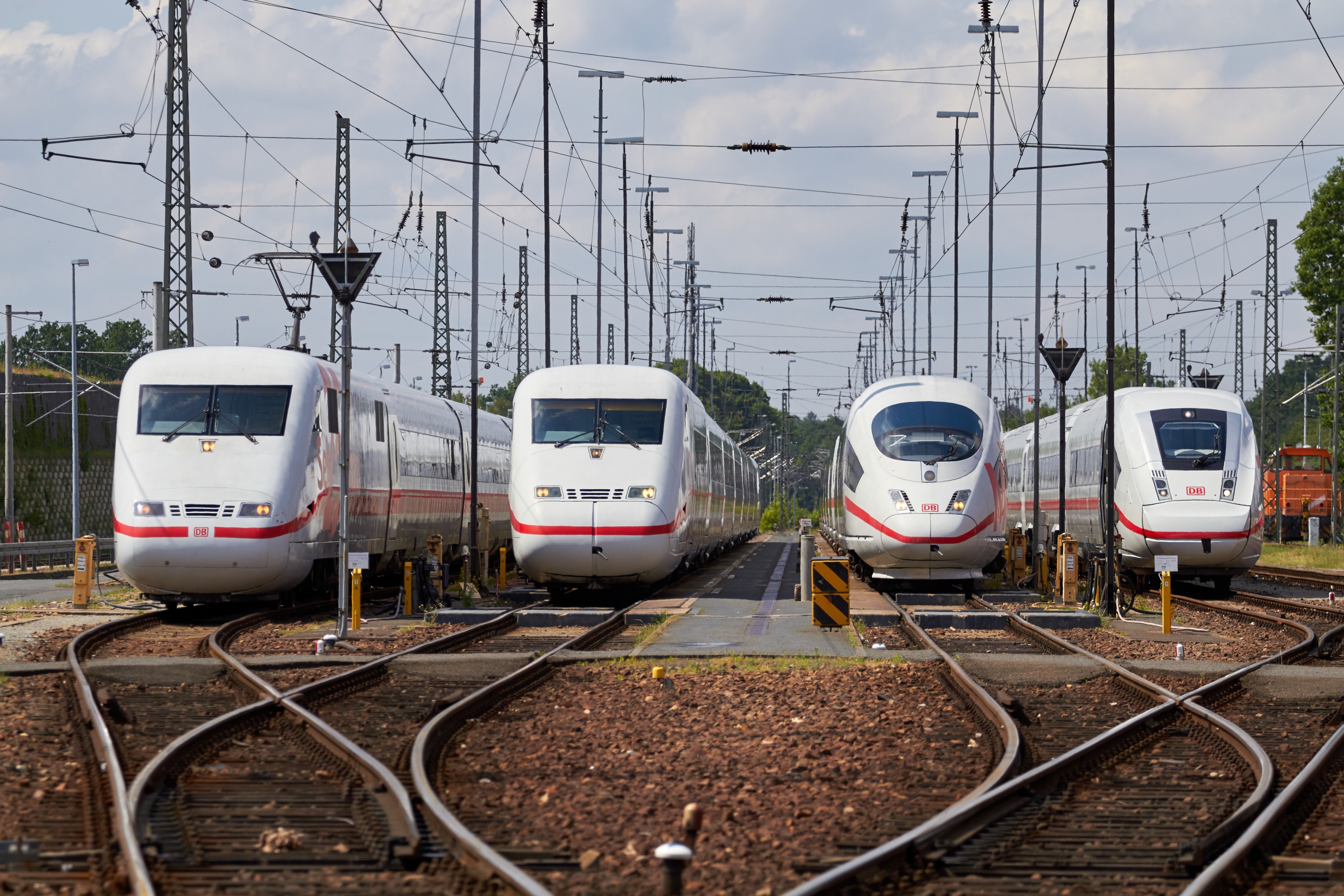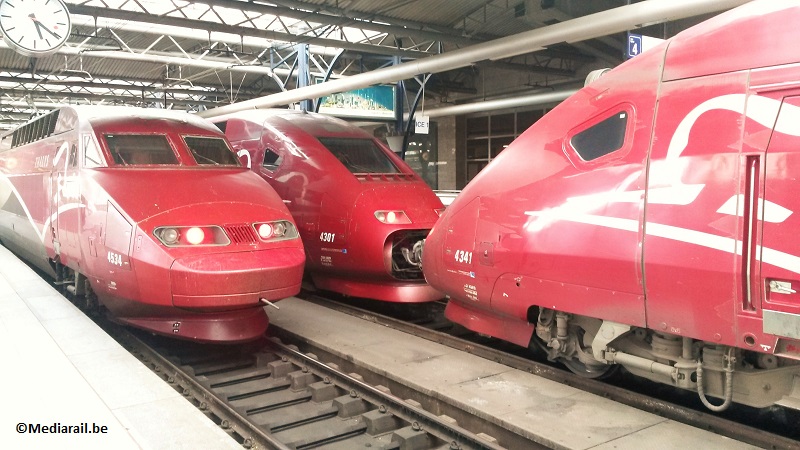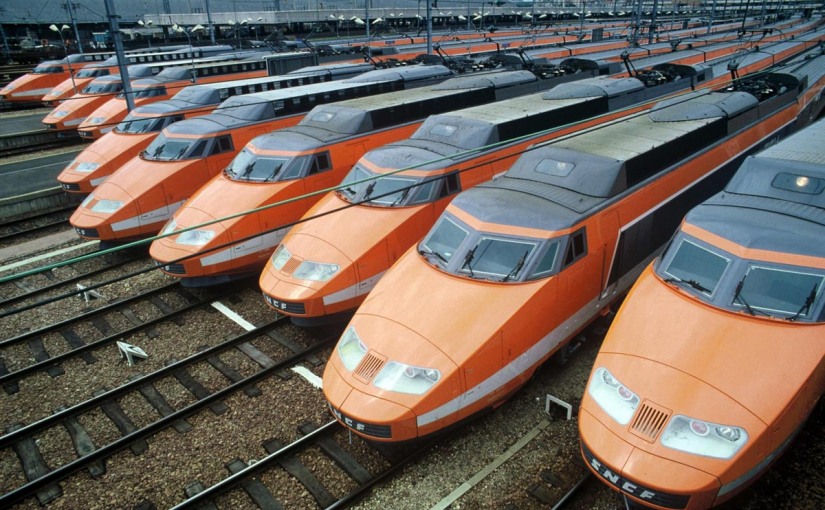19/09/2021 – By Frédéric de Kemmeter – Railway signalling and freelance copywriter – Suscribe my blog
(Version en français)
🟧 See also a review of railway news on this page
The TGV in France (Train à grande vitesse) is an undeniable success. To run continuously at 300km/h was something that still seemed utopian in the early 1970s, despite much research in Europe. At that time, France still had to choose between the “old” wheel-rail technique of the SNCF and Alsthom (with an “h”), or a more disruptive technology promoted through the Bertin aerotrain. There is still many historical controversies today about the intense lobbying deployed by the SNCF to avoid this technological competition that threatened the wheel-rail technique, but it is difficult to tell the difference. In the end, it was the ‘train’ that was chosen by President Pompidou, who was not a great fan of trains.
Infrastructure
Very quickly, it became clear that in order to run at 300km/h, it was necessary to have an infrastructure of its own, while retaining the essentials of railway technology: rails, ballast and energy distributed by catenary. The TGV was thus an opportunity to rebuild a new network and to bypass the many handicaps of the “old railway”, with its tight curves, tunnels, ageing bridges, multiple stations and a large number of switches. The new high-speed lines put a new spin on the civil engineering approach.
However, running at 300km/h meant that the curves had to be smoothed out to a radius of 4,000m, intermediate stations and level crossings had to be removed, and a more generous longitudinal profile had to be chosen, with gradients of 35m per kilometre (instead of 20m on a conventional line), which made a TGV line special for self-propelled trains only. The design also differed in terms of maximum permissible tonnage: 17 tonnes per axle instead of 22.5 tonnes on the conventional network, so as not to damage or wear out the track.
Finally, as it is impossible to react in time with lateral light signalling, the TGV was automatically equipped with in-cab signalling, the forerunner of what is now ETCS.
On 22 September 1981, François Mitterrand, newly elected President of the Republic, inaugurated the first high-speed train service between Paris and Lyon. Commercial service was opened to the public began five days later, on 27 September. The adventure of the TGV “à la française” began. It gave pride of place to the ideas of the SNCF and also Alsthom.
Competing with aviation
The TGV’s main objective was to compete with the airline industry rather than the road. With its orange livery designed to make people forget the depressing military green of the railway, the TGV redrew the map of travel in France and trains gradually moved beyond Lyon to Geneva, Lausanne, Marseille, Montpellier and Nice. For about fifteen years, it had a sympathetic ear all over the world. Then came other TGVs in Europe: ICE in Germany and TAV in Italy, inaugurated in the early 1990s, without the Alsthom concept.
After the south-east, the French high-speed network was extended first to Tours (September 1990) and then to Arras and Lille (May 1993). In December 1997, for the first time in Europe, a high-speed line crossed the border to Brussels. The TGV became an international showcase for Alsthom and SNCF. Then there was the high-speed line to the Mediterranean, connecting Montpellier and Marseille (2001), the ‘TGV-Est line’, linking Paris to Strasbourg from 2007 and the TGV Rhin-Rhône, inaugurated in 2011 between the south of Belfort and the Dijon area. Finally, the Tours-Bordeaux line and branches to Rennes, also known as the “LGV L’Océane” by the SNCF, were inaugurated in July 2017.
Disappointment in exports
Alstom has tried to sell his product worldwide, with more mixed success than expected. South Korea, Spain, Italy (AGV trainsets) and Morocco are the only countries to have bought the articulated TGV “à la française”. Alstom’s AGV, which SNCF did not want, is operated only through the private Italian operator NTV-Italo.
The articulated train concept was not always convincing and Alstom sometimes underestimated the weight of its competitors in some parts of the world. On the technical side, both Siemens and the former Italian consortium Trevi (which built the ETR500), as well as Bombardier (now Hitachi Rail Europe), preferred the concept with the classic bogies trainset, which also proved to be comfortable and stable. Only Talgo has also kept its articulated train, but according to its historical design. Talgo has succeeded in selling its high-speed train based on this technology to Saudi Arabia.
What results after 40 years?
When we look at the TGV map today, we can see that the SNCF has taken up the old idea of what is known in France as the “Étoile de Legrand” (Legrand hub-and-spoke), i.e. a network entirely centred on Paris. The culture of a strong capital city that connects the “provincial cities” remains alive in the country. The SNCF considered – and still considers – that the Parisian flows are economically the most promising.
In the light of the results over nearly 40 years, it is clear that the TGV has never succeeded – both in France as elsewhere in Europe – in emptying the motorways. This is because the TGV is aimed at a city-to-city clientele that does not need a vehicle at its destination. But this option therefore excludes all destinations outside the cities, which are much more numerous than one might think, especially during the summer holidays. The French TGV is clearly a product designed to bring down short-haul aviation, and it can be said that it has partially succeeded, even if there are still domestic flights today to feed international and intercontinental air connections, mainly at Charles de Gaulle airport in Paris.
The TGV has also made it possible to renew the image of the train internationally, and it can be said that in the case of Thalys, Eurostar or Lyria (to Switzerland), it is a success for French ‘savoir-faire’.
New generation
The PSE trainsets (Paris Sud-Est), which had become obsolete over time with their DC motors, finally left the railway scene only after 35 years of service, demonstrating the technical success of this highly innovative train in 1981. The TGV-Atlantique trains, which were launched in 1990, are also going into retirement. They are now replaced by the TGV « L’Océane », which are well different from the previous ones. The 40 years of high-speed rail have shown the undeniable success of the French TGV, which has remained faithful to the technical design of the articulated train, with nearly 400 trainsets in service today. Alstom’s next series of TGV-M trains will renew the articulated train concept and the SNCF has ordered nearly 100 trainsets. Happy birthday, TGV…
>>> Others news here
Suscribe by mail to connect with railway information
More informations:
 Boris Johnson gives green light to the high-speed rail line HS2
Boris Johnson gives green light to the high-speed rail line HS2
12/02/2020 – With its cost of almost €118 billion, the HS2 high-speed line will be built to improve railway service between London and the center of England. HS2 will be the second high speed railway in the United Kingdom, following HS1 build in 2007.
 The Texan high speed railway project is progressing well
The Texan high speed railway project is progressing well
25/02/2020 – It gets little publicity , but it seems to be moving forward. The Texan TGV is an issue that attracs our attention because European companies are involved in it. It is also fundamentally different from the Californian dossier, which is getting bogged down. Why?
 Happy birthday, InterCity Express
Happy birthday, InterCity Express
30/05/2021 – 10 years after the launch of the first high-speed train in France, Germany launched its own high-speed train called « InterCity Express » (ICE). This is an opportunity to look back at the German concept, which differs from the French options. The arrival of the ICE has allowed Deutsche Bahn – and Siemens -, to become one of the world’s leading high-speed railways.
 Thalys: 25 years old and a future to consolidate
Thalys: 25 years old and a future to consolidate
06/06/2021 – Since the 1980s, a project for an international high-speed train had been in the making. In October 1987, a political decision in Brussels was made to build a high-speed network between France and northern Europe, including the Netherlands, Germany and the UK. Now Thalys have 25 years old.
 How can the train win back business travellers?
How can the train win back business travellers?
17/07/2020 – Business customers have high expectations when it comes to travel. The train can conquer this clientele but under certain conditions.xxxxxxxxxxxxxxxxxxxxxxxxxxxxx xxxxx xxxxxxxxxx xxxxxxxxxx xxxxxxxxxxx
 Can the train really replace the plane?
Can the train really replace the plane?
28/06/2021 – The train could replace some 500 to 1000km flights. Mentalities seem to be evolving in this direction and the average travel time would increase. But there are still a number of conditions for this replacement. xxxxxxxxxxxxxxxxxxxxxxxxxxxxx xxxxx xxxxxxxxxx xxxxxxxxxx xxxxxxxxxxx


Vous devez être connecté pour poster un commentaire.